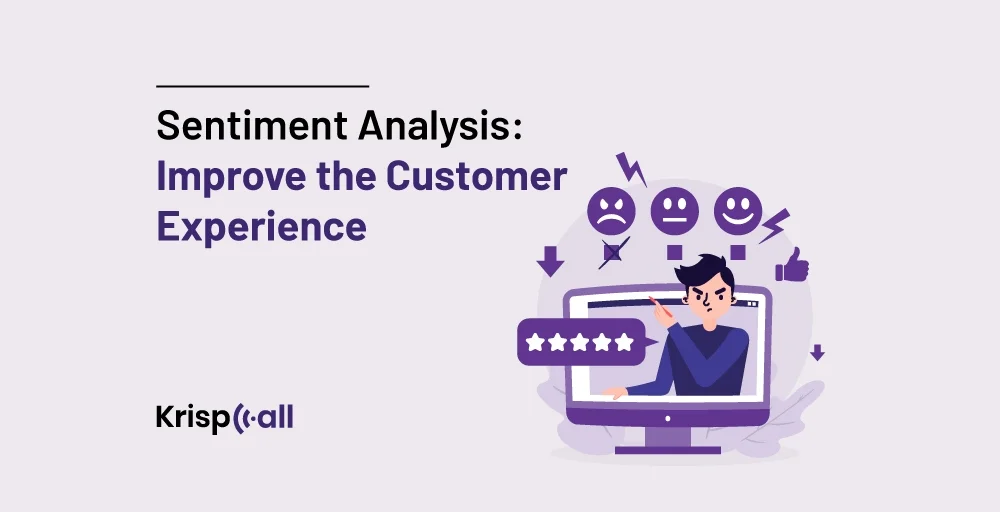Are you having a problem to improve your customer experience but don’t know how? 🤔
No worries!!! 🤩 We’ll help you. With sentiment analysis, you can enhance 📈 your customer experience using various efficient measures. It helps to determine the emotional tone of a customer’s feedback, reviews, or comments using different Natural Language Processing techniques.
In this blog, we will cover how sentiment analysis can be beneficial for your customer service, its benefits, how it works, where we can use it, and challenges that may occur while conducting sentiment analysis.
🔑 KEY HIGHLIGHTS
- Customer sentiment analysis is the automated process of analyzing customer feedback and reviews to discover their sentiments toward products.
- Sentiment analysis uses natural processing language techniques to determine the sentiment of the piece of text.
- Sentiment Analysis can analyze unstructured data such as comments, feedback, emails, and survey responses to determine their sentiment.
- Sentiment Analysis provides efficient measures to enhance business productivity.
What is Sentiment Analysis?

Sentiment analysis is the process of classifying and analyzing digital text to determine the emotion of a sentence. SA, a short form of sentiment analysis, uses Natural Language Processing to determine the emotional tone of a message: positive, negative, or neutral.
Sentiment analysis can analyze unstructured data such as comments, feedback, emails, and survey responses to determine their sentiment. With the use of sentiment analysis, we can determine the sentiment or emotional tone of a piece of text. Businesses with large volumes of customer feedback can be analyzed automatically to get their sentiments toward products.
Let’s take a basic example of how sentiment analysis works on movie reviews.
Review of the movie: The movie was wonderful. The acting and story were superb. Overall, I love the movie.
The sentiment of a movie review: The sentiment is positive. It uses positive words like wonderful, superb, and love.
How Does Sentiment Analysis Work?
Sentiment analysis, as said earlier, uses NLP techniques to determine the sentiment of the piece of text. As part of its process, it involves breaking down text into components, assigning sentiment scores to each component, and using machine learning algorithms to classify sentiments accurately.
Generally, sentiment analysis algorithms fall into three categories: rule-based, automatic, and hybrid. Nonetheless, all of these categories largely have the same technique of analysis.
The steps involved in sentiment analysis are:
- Text Preprocessing: The first step of sentiment analysis is refining the text using different preprocessing techniques. This involves tokenization (converting text into words and phrases) and removing punctuations and stopwords(like “the,” “is,” “and”).
- Clue identification: After pre-processing, the next step is to identify emotions in the text. Words that convey excitement, happiness, and satisfaction can be positive words. While words that convey anger, frustration, and sadness can be negative words.
- Context Matter: Analyzing the context of whole words or phrases to get actual emotions. Sometimes, words such as “good” can provide both positive and negative sentiments. Let’s take an example to understand.
a) This is a good movie. [Positive sentiment]
b) This is not a good movie [Negative sentiment]
- Sentiment Scoring: Assign the sentiment score to the text after analyzing the clue and context.
- Positive text: Assign them positive sentiment. Score them 1.
- Negative text: Assign them negative sentiment. Score them -1.
- Neutral Text: Assign them neutral sentiment. Score them 0.
Note: The score can be determined between 0-1 or 0-5.
What Is Sentiment Analysis Used For?
Sentiment analysis is used to improve customer service. It is also useful to gain insight into areas such as market research, support strategy, product development, and many more, which are defined below:
- Improve Customer Experience: By using a sentiment analysis tool, your company can identify the negative sentiments of the customers and proactively understand them. So that you will be able to anticipate and prevent problems of the customers beforehand. This will quickly help to improve customer experience and satisfaction.
- Manage Your Brand’s Reputation: In today’s world, people share their opinions openly on social media. So, any negative sentiment can greatly harm your brand reputation. Therefore, by using support experience software, you can analyze customer sentiments and identify negative opinions to solve them and build a positive brand reputation.
- Conduct Market Research: Sentiment analysis also helps in conducting market-wide research to connect with your customers by understanding how your customers react to your products or what they think about your product. This will help you to uncover areas where your product needs to improve.
- Refine Your Support Strategy: In addition to improving your customer service, sentiment analysis also helps to refine your entire CRM strategy to meet customer’s expectations. With this, you can meet customer’s standards and turn an unhappy customer into a lifelong customer.
- Fuel Innovation and Product Development: Sentiment analysis makes it possible to get insights from unstructured data that reveal the features that customers want and the differences between your product and those of your rivals. You can use these insights to innovate new products.
Benefits of Sentiment Analysis
Sentiment analysis provides many features for the business. Some of the benefits of sentiment analysis are:
- Improved customer understanding: Using customer sentiment, businesses can gain deeper insights into customers’ needs, expectations, and preferences. It enables companies to tailor their services and products to meet customer demands.
- Enhanced customer satisfaction: Sentiment analysis helps to identify negative tone in a customer review and can be used to measure customer satisfaction with our service. Businesses can gauge the effectiveness of provided customer service and identify areas for further improvement.
- Product Development: Customer comments, reviews, or feedback on products help companies improve their products in the future. It allows companies to know what features customers need and require, which helps enhance product development.
- Predictive Analysis: By analyzing data using sentiment analysis, the company can make predictions and identify patterns for future preferences. SA helps to identify the future behavior or activities of customers using previous data.
- Fraud Detection: With sentiment analysis, companies can identify suspicious behavior or negative sentiments. Fraud can be detected if suspicious activity is associated with fraudulent behavior.
Note: Sentiment analysis can be beneficial in detecting potential fraud in a company. Fraud can lead to both financial and data losses. It not only helps determine the sentiment of text but also helps protect company data and its reputation by preventing potential fraud.
How Can Sentiment Analysis Be Used To Improve Customer Experience?
Customer sentiment analysis is the automated process of analyzing customer feedback and reviews to discover their sentiments toward products. Various sentiment analyses can be performed to improve customer experience.
Among them, common five measures are :
1. Proactive in Problem-Solving
By discovering negative comments or sentiments early, the company can take proactive steps to resolve problems. Addressing customer concerns early helps to solve their issues before they escalate. It helps to reach the unhappy customer and fix their issues.
For instance, a company might spot negative feedback about its product through sentiment analysis and promptly contact the customer to resolve the issue before it escalates.
2. Inspect Customer Voices
You can use sentiment analysis to analyze the customer’s voice, reviews, comments, feedback, social media posts, and polls to understand their sentiments toward your products. This helps businesses identify customer sentiments in particular areas and allows them to know whether the customer is happy or frustrated using our products.
As an example of this, when a hotel chain notices that online reviews complain about slow Wi-Fi, it upgrades its infrastructure accordingly.
3. Personalized Interaction
Sentiment analysis can be used to personalize customer interaction. Using past interactions to determine whether the customer is happy or frustrated with our services. By understanding customers’ sentiments, companies can tailor their communication and style to achieve customer satisfaction.
For example, a happy customer might be appreciated with a more upbeat approach, while an unhappy or frustrated customer needs a more empathetic tone.
4. Product Development
Analyzing customer valuable feedback for product development. Customer comments, reviews, or feedback on products help companies for a better improvement of the products in the future. It allows to know what customers need and require as features which helps to enhance product development.
In this case, a software company might receive multiple requests about the addition of a certain product. Then analyses the sentiment around its actual need and prioritizes adding the requested feature to improve user satisfaction.
5. Measure customer satisfaction
Sentiment analysis can be used to measure the level of customer satisfaction with our service. Monitoring the sentiment score of customers in specific products or services aids in enhancing improvement. Businesses can gauge the effectiveness of provided customer service and identify areas for further improvement.
By way of example, a telecom company sees an increase in positive sentiment scores in all of its DEXs after implementing agent training, validating its effectiveness.
Challenges While Conducting Sentiment Analysis
Performing sentiment analysis requires many complex processes as it involves different Natural Language Processing techniques. While executing sentiment analysis on your data or text, many issues may arise.
Some common challenges that may occur in sentiment analysis are:
- Sometimes, understanding context may be difficult because of language complexity. For example, humor or sarcasm might be misinterpreted as negativity.
- As SA contains limited pre-defined lexicon words. Some jargon, slang, or emerging expressions that may not be included in SA’s vocabulary, leads to inaccurate results.
- Sentiment analysis is performed using trained data sets. If the dataset is biased, the results will be biased too. Using diverse data set tools helps to overcome those problems.
Conclusion
Sentiment analysis isn’t just about finding the emotional tone of a particular text. It provides powerful tools that help to bridge the gap between customer emotion and business action. Using sentiment analysis, businesses can gain valuable insights into the customer and their relationship with the company.
Sentiment Analysis provides efficient measures to enhance the productivity of businesses. With the use of SA, businesses can inspect customer voices, proactively solve issues, personalize interactions, and measure customer satisfaction. It also offers sophisticated tools for businesses that help optimize their products and services.





